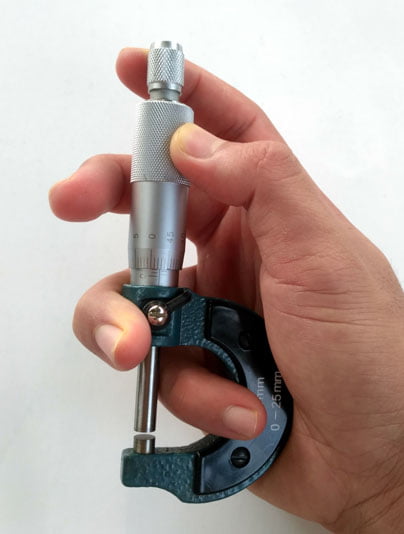The first time using a micrometer, you may get a little stunning fuzzy because you don’t know what to start from. Can’t keep silent, you decide to try measuring. Stop it, please! You could ruin the micrometer’s accuracy because rotating the thimble too tight.
Using a micrometer is actually easy. There are only some steps to do. From the start to the end, the steps can be divided into some detailed ideas. However, the most highlighted aspects are how to hold it and how to use the ratchet. You need some guides for these things or your micrometer will be a guinea pig.
Things to do before using the micrometer:
- Check the temperature
- Calibrate
- Zero the micrometer
- Clean the micrometer
1. Recognize the Micrometer Body Parts
Understanding the body parts of a micrometer is a basic task you need to know before using it. The key parts that you need to know are the frame, lock, thimble barrel, and ratchet stop. These are the parts where your fingers are positioned in order to hold the micrometer properly.
2. Micrometer Stand or Handheld?
After recognizing the body parts, you have to decide which method to use. You need to know that you can choose whether using a micrometer stand or by the handheld.
If you rely on the micrometer stand, it’s good. The micrometer stand is advantageous in improving accuracy because it helps prevent heat transfer from your body. By handheld is also nice. You can measure anything anywhere and anytime. However, we have to notify you. On one side, using a micrometer by handheld is simple, compact, and quick, on the other hand, it increases measurement inaccuracy because your hand is directly contacting the micrometer so that lets the heat from your body transfer easily.
3. Hold the Micrometer Properly

After deciding what method to use, you can go further to the way of holding it. In this case, we suppose that you choose the handheld one.
Firstly, set your pinkie finger wrapping the frame. Secondly, put your ring finger on the top of the barrel near the spindle lock, give a little pressure so that your ring finger grasp the barrel toward your palm. Thirdly, let your middle finger free or it can help your ring finger grasp the micrometer. Fourthly, your thumb and index finger function to rotate whether the ratchet stop or thimble.
In short, the fingers are divided into two major tasks: one for holding and the other for rotating. You can follow it by the image beside or you can see it on the video below.
4. Rotate the Thimble
Once you hold the micrometer properly, it’s time to rotate the thimble. In this section, you have to carefully spin it because if you are too tight in securing the object, the measurement can be inaccurate. Whereas, if you secure the object too weakly, the measurement will be similar. Fortunately, here the function of the ratchet stop.
You can rotate the thimble, and once the object is almost secured, rotate the ratchet stop. If you have heard some “click” sounds, you have to stop rotating and start reading the measurement. Or use both your thumb and index finger to rotate the ratchet, once hear the sound, stop it and take the reading.
You can repeat the process until the scale shows the same reading for several tries. If you are sure, means it’s consistent, the reading can be taken. In addition, you also have to make sure that it measures without zero error.
How do you know that the object is secured with the predetermined pressure?
As mentioned before, the function of the ratchet is to give an allowed force in rotating the thimble. You may too tight or too weak rotating it so it interferes the reading. By using the ratchet, if the predetermined force meets the point where the accurate reading means to be, no matter how many times you rotate the ratchet, the thimble will not move again. However, if you use your own fingers, you can force it and it moves tighter until breaks the micrometer.
5. Take the Reading
Lastly, you can get rid of the object, read the micrometer, and note the measurement if needed. Remember that even a slight slip of the thimble can disrupt the measurement. Therefore, it’s very recommended turning adequately the lock nut to lock the spindle and prevent it moves before taking the reading.
What do you think? Is it easy? Sure. The most important aspect of using a micrometer is the use of the ratchet. If you fail to use it properly, the reading is failed, too. Similarly, if you rotate it carefully and use the ratchet at the last time when the object is almost tightened, the reading should be accurate. In addition, the use of a micrometer stand also helps in improving accuracy. However, using fingers is surely easier, simpler, and faster.
